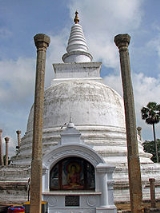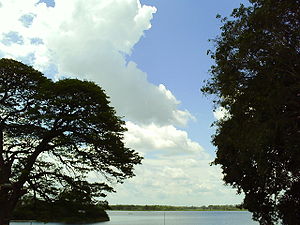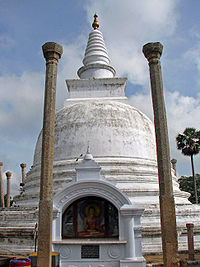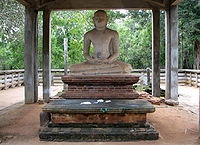
Ancient Constructions of Sri Lanka
Encyclopedia
The Ancient Sinhalese
excelled in the construction of tanks
(Wevas) or reservoir
s, dagoba
s (or Stupa
s) and palace
s, as evident from the ruins which displays a rich variety of Architectural forms.
 Major irrigation
Major irrigation
schemes of Sri Lanka
, as evident from the earliest written records in the Mahawansa, date back to the fourth century BC (Parker
, 1881; Brohier, 1934). The purpose and determination in the construction of the irrigation systems are depicted by the words of Parakrama Bahu the Great
, 1153–1186 AD: "Let not even a drop of rain water go to the sea without benefiting man".
The Sri Lankan Chronicle, the Culavamsa which was written in the Buddhist canonical language Pali, enumerates his works both as a provincial ruler in western Sri Lanka and later as the monarch of the whole country: he either built or restored 163 major tanks (reservoirs), 2,617 minor tanks, 3,910 irrigation channels, 328 stone sluices and 168 sluice blocks, besides repairing 1,969 breaches in embankments. Among the reservoirs he built was the tank at Polonnaruwa
, called on account of its size the Parakrama Samudra
(translation: Sea of Parakrama). With an area of 30 km² and an enclosing embankment 14 kilometres long, it irrigated nearly 100 km².
The final achievements were highlighted by Sir Henry Ward, Governor of Ceylon: It is possible, that in no other part of the world are there to be found within the same space, the remains of so many works of irrigation, which are, at the same time, of such great antiquity, and of such vast magnitude as Ceylon. Probably no other country can exhibit works so numerous, and at the same time so ancient and extensive, within the same limited area, as this Island.
Tanks are locally termed 'Weva's (plural: Wew).
 The dagobas or stupas are distinctive for many reasons. They are probably the largest brick structures known to the pre-modern world. Demala Maha Seya, which was never completed, had a circumference of 2011 feet. Jetavanaramaya
The dagobas or stupas are distinctive for many reasons. They are probably the largest brick structures known to the pre-modern world. Demala Maha Seya, which was never completed, had a circumference of 2011 feet. Jetavanaramaya
is the largest stupa constructed in any part of the world. It is over 120 metres in height and has a diameter of 367 feet. The foundation is 252 feet deep. The deepest known foundation of the ancient world. It needed bricks that could bear the load of 368 pounds. Jetavana
was the third tallest building in the ancient world. Abhayagiri
(370 feet) ranked fifth and Ruvanvelisaya (300 feet) came seventh. The first, fourth and sixth places were held by the pyramids.
since ancient times, fine examples if these include the magnificent cave temple complex in Dambulla
built by king Valagamba. Cave temples has preserved some of the best examples of Sinhalse art and Sinhalese architecture. In the years gone by of monarchy rule in ancient Sri Lanka the rock cave shelters cloistered in the recess of the forests served the recluse Buddhist monks in performing their meditation chores and other religious observances. Such cave hermitages were patronised by the ruling kings of the time, chieftains and the people as well. As the years passed, such cave shelters turned into len viharas (cave temples) and len avasas (abodes of Buddhist monks). Such len (cave shelters), were gifted by the kings, queens, and other nobles of the royalty. Foremost among such noble chieftains were the paramukas (chieftain of royal rank holding multiple designations).

Sinhalese people
The Sinhalese are an Indo-Aryan ethnic group,forming the majority of Sri Lanka,constituting 74% of the Sri Lankan population.They number approximately 15 million worldwide.The Sinhalese identity is based on language, heritage and religion. The Sinhalese speak Sinhala, an Indo-Aryan language and the...
excelled in the construction of tanks
Irrigation tank
For etymology, see Storage tank#Etymology.In India, an irrigation tank or tank is an artificial reservoir of any size. . It can also have a natural or man-made spring included as part of a structure...
(Wevas) or reservoir
Reservoir
A reservoir , artificial lake or dam is used to store water.Reservoirs may be created in river valleys by the construction of a dam or may be built by excavation in the ground or by conventional construction techniques such as brickwork or cast concrete.The term reservoir may also be used to...
s, dagoba
Dagoba
Dagoba may refer to:*Dagoba, the French metal band.* Dagoba Chocolate, a brand of organic chocolate.*Dagobah, the fictional planet from the Star Wars universeor*Stupa, the Buddhist building style....
s (or Stupa
Stupa
A stupa is a mound-like structure containing Buddhist relics, typically the remains of Buddha, used by Buddhists as a place of worship....
s) and palace
Palace
A palace is a grand residence, especially a royal residence or the home of a head of state or some other high-ranking dignitary, such as a bishop or archbishop. The word itself is derived from the Latin name Palātium, for Palatine Hill, one of the seven hills in Rome. In many parts of Europe, the...
s, as evident from the ruins which displays a rich variety of Architectural forms.
Irrigation Works

Irrigation
Irrigation may be defined as the science of artificial application of water to the land or soil. It is used to assist in the growing of agricultural crops, maintenance of landscapes, and revegetation of disturbed soils in dry areas and during periods of inadequate rainfall...
schemes of Sri Lanka
Sri Lanka
Sri Lanka, officially the Democratic Socialist Republic of Sri Lanka is a country off the southern coast of the Indian subcontinent. Known until 1972 as Ceylon , Sri Lanka is an island surrounded by the Indian Ocean, the Gulf of Mannar and the Palk Strait, and lies in the vicinity of India and the...
, as evident from the earliest written records in the Mahawansa, date back to the fourth century BC (Parker
Henry Parker (author)
Henry Parker was a British engineer in colonial Ceylon during the Victorian era. He was attached to the Irrigation Department from 1873 to 1904. During his work as engineer he developed an admiration for the skills displayed by the ancient Sinhalese at the time of the construction of their...
, 1881; Brohier, 1934). The purpose and determination in the construction of the irrigation systems are depicted by the words of Parakrama Bahu the Great
Parâkramabâhu I
Parākramabāhu I was king of Sri Lanka from 1153 to 1186. During his reign from his capital Polonnaruwa, he unified the three sub kingdoms of the island, becoming one of the last monarchs in Sri Lankan history to do so...
, 1153–1186 AD: "Let not even a drop of rain water go to the sea without benefiting man".
The Sri Lankan Chronicle, the Culavamsa which was written in the Buddhist canonical language Pali, enumerates his works both as a provincial ruler in western Sri Lanka and later as the monarch of the whole country: he either built or restored 163 major tanks (reservoirs), 2,617 minor tanks, 3,910 irrigation channels, 328 stone sluices and 168 sluice blocks, besides repairing 1,969 breaches in embankments. Among the reservoirs he built was the tank at Polonnaruwa
Polonnaruwa
The second most ancient of Sri Lanka's kingdoms, was first declared the capital city by King Vijayabahu I, who defeated the Chola invaders in 1070 AD to reunite the country once more under a local leader.-History:While Vijayabahu's victory and shifting of Kingdoms to the more strategic Polonnaruwa...
, called on account of its size the Parakrama Samudra
Parakrama Samudra
Parakrama Samudra is a shallow reservoir, consisting of three separate reservoirs connected by narrow channels in Polonnaruwa, Sri Lanka....
(translation: Sea of Parakrama). With an area of 30 km² and an enclosing embankment 14 kilometres long, it irrigated nearly 100 km².
The final achievements were highlighted by Sir Henry Ward, Governor of Ceylon: It is possible, that in no other part of the world are there to be found within the same space, the remains of so many works of irrigation, which are, at the same time, of such great antiquity, and of such vast magnitude as Ceylon. Probably no other country can exhibit works so numerous, and at the same time so ancient and extensive, within the same limited area, as this Island.
Reservoirs
A wealth of river basin based water heritage is abundant in Sri Lanka. Reservoirs of Sri Lanka (Ceylon) are different from the water tanks we see in ancient civilisations or bodies of water collected for purposes such as generation of electricity or supplying water for consumption.Tanks are locally termed 'Weva's (plural: Wew).
- Kala WewaKala WewaKala Wewa is an ancient reservoir in Anuradhapura, Sri Lanka. It was built by King Dhatusena around 400 AD. This reservoir has a circumference of and has a total area of at full capacity.-References:...
- Parakrama SamudraParakrama SamudraParakrama Samudra is a shallow reservoir, consisting of three separate reservoirs connected by narrow channels in Polonnaruwa, Sri Lanka....
ya or Sea of Parakrama - MinneriyaMinneriyaMinneriya is a small town in Sri Lanka, and is famous for two things , for the great Minneriya lake build by King Mahasen and for the Minneriya National Park which is a hot spot for safari lovers because of the abandons of Elephants...
- Kantale Weva
- Ridiyagama
- Yoda weva
- Tissa weva
- Badagiriya
- Lunugamwehera
- Muruthawela
- Hurulu weva
- Abhayavapi tank
- Nuwara weva
- Naccaduwa wewa
Stupas of Ancient Sri Lanka

Jetavanaramaya
The Jetavanaramaya is a stupa, located in the ruins of Jetavana Monastery in the sacred world heritage city of Anuradhapura, Sri Lanka. King Mahasena initiated the construction of the stupa following the destruction of Mahavihara, his son Maghavanna Ithe construction of the stupa...
is the largest stupa constructed in any part of the world. It is over 120 metres in height and has a diameter of 367 feet. The foundation is 252 feet deep. The deepest known foundation of the ancient world. It needed bricks that could bear the load of 368 pounds. Jetavana
Jetavana
Jetavana was one of the most famous of the Buddhist monasteries in India. It was the second monastery donated to Gautama Buddha, after the Veluvana in Rajagaha. Jetavana is located just outside the old city of Savatthi...
was the third tallest building in the ancient world. Abhayagiri
Abhayagiri
Abhayagiri may refer to:* Abhayagiri vihāra a ruined monastic complex of great historical significance in Sri Lanka.* Abhayagiri Buddhist Monastery, a Theravadin Buddhist monastery in Redwood Valley, California....
(370 feet) ranked fifth and Ruvanvelisaya (300 feet) came seventh. The first, fourth and sixth places were held by the pyramids.
- RuwanwelisayaRuwanwelisayaThe Ruwanwelisaya is a stupa in Sri Lanka, considered a marvel for its architectural qualities and sacred to many Buddhists all over the world. It was built by King Dutugemunu, who became lord of all Sri Lanka after a war in which the Chola King Elara, was defeated...
- ThuparamayaThuparamayaThuparamaya is a dagoba in Anuradhapura, Sri Lanka. It is a Buddhist sacred place of veneration.Mahinda Thera, an envoy sent by King Ashoka himself introduced Theravada Buddhism and also chetiya worship to Sri Lanka. At his request King Devanampiyatissa built Thuparamaya in which was enshrined the...
- Ridi Vihara
- LovamahapayaLovamahapayaLovamahapaya is a building situated between Ruvanveliseya and Sri Mahabodiya in the ancient city of Anuradhapura, Sri Lanka. It is also known as the Brazen Palace or Lohaprasadaya because the roof was covered with bronze tiles....
- Abhayagiri DagabaAbhayagiri DagabaAbhayagiri vihāra is situated in Anuradhapura, Sri Lanka. It is one of the most extensive ruins in the world and one of the most sacred Buddhist pilgrimage cities in the nation. Historically it was a great monastic centre as well as a royal capital, with magnificent monasteries rising to many...
- Jetavanarama
- Mirisaveti StupaMirisaveti StupaThe Mirisaveti Stupa is situated in the ancient city of Anuradhapura, Sri Lanka. King Dutugamunu built the Mirisaveti Stupa after defeating King Elara. After placing the Buddha relics in the sceptre, he had gone to Tisawewa for a bath leaving the sceptre. After the bath he returned to the place...
- LankaramaLankaramaLankarama is a stupa built by King Valagamba, in an ancient place at Galhebakada in the ancient kingdom of Anuradhapura, Sri Lanka. Nothing is known about the ancient form of the stupa, and later this was renovated. The ruins show that there are rows of stone pillars and it is no doubt that there...
- IsurumuniyaIsurumuniyaIsurumuniya is a Buddhist temple situated near to the Tisawewa .-History:The temple was built by King DEVANAMPIYATHISSA who ruled in the ancient Sri Lankan capital of Anuradhapura. After 500 children of high-caste were ordained, Isurumuniya was built for them to reside...
- Rathna PrasadayaRathna PrasadayaRathna Prasadaya was a skyscraper built by King Kanittha Tissa who ruled Ceylon from 167 to 186 AD. Mihindu II and Mihindu IV renovated the building during the 8th and 10th centuries. The bhikkhus of the Tapovana belonging to the Pansakulika sect resided here. Beautiful guard stones of the...
- Dakkhina StupaDakkhina StupaDakkhina Stupa also called Dakkhina Tupa is a 2nd century BC stupa built over the cremated ashes of King Dutugemunu. The Bhikkhus of the Sagalika sect resided here. It was constructed by Uttiya, a Minister of King Valagamba, in the Ancient Sacred city of Anuradhapura, Sri Lanka...
- Sela CetiyaSela CetiyaSela Cetiya is one of the 16 main places of worship or Solosmasthana and is situated to the west of Jetavanaramaya in the ancient sacred city of Anuradhapura, Sri Lanka. This was constructed by King Lajjitissa who ruled in the 1st century BC. The diameter of the base of the stupa is 37 ½ feet. This...
- Naka ViharaNaka ViharaNaka Vihara is a stupa, or Buddhist religious monument, built with bricks and square in shape. The stupa is located in Anuradhapura, Sri Lanka. The site was constructed according to an unusual model and would have been similar to the seven story building in Polonnaruwa, Sri Lanka. Excavations done...
- Kiribath VeheraKiribath VeheraKiribath Vehera is situated in the ancient sacred city of Anuradhapura, Sri Lanka. The remains of this vihara shows that it is 30 feet in height and the circumference is 425 feet. The date of construction and the king who built it, is unknown. In close proximity to this are the ruins of an image...
- Pubbarama
- Tapovana
Cave Temples of ancient Sri Lanka
Cave temples had been used in Sri LankaSri Lanka
Sri Lanka, officially the Democratic Socialist Republic of Sri Lanka is a country off the southern coast of the Indian subcontinent. Known until 1972 as Ceylon , Sri Lanka is an island surrounded by the Indian Ocean, the Gulf of Mannar and the Palk Strait, and lies in the vicinity of India and the...
since ancient times, fine examples if these include the magnificent cave temple complex in Dambulla
Dambulla
The city of Dambulla is situated in the Matale District in the Central Province of Sri Lanka, situated 148 km north-east of Colombo and 72 km north of Kandy....
built by king Valagamba. Cave temples has preserved some of the best examples of Sinhalse art and Sinhalese architecture. In the years gone by of monarchy rule in ancient Sri Lanka the rock cave shelters cloistered in the recess of the forests served the recluse Buddhist monks in performing their meditation chores and other religious observances. Such cave hermitages were patronised by the ruling kings of the time, chieftains and the people as well. As the years passed, such cave shelters turned into len viharas (cave temples) and len avasas (abodes of Buddhist monks). Such len (cave shelters), were gifted by the kings, queens, and other nobles of the royalty. Foremost among such noble chieftains were the paramukas (chieftain of royal rank holding multiple designations).
- VessagiriVessagiriVessagiri, or Vesagiriya, is a series of stone rocks and caves that are part of the ruins of Anuradhapura, one of the ancient capitals of Sri Lanka. They are located about half a mile south of Isurumuniya, in a mountainous region. Above the caves are inscribed the names of donors written in Brahmi...
- Dambulla Rock Temple
- Pilikuththuwa Raja Maha Vihara
- Aluvihara Rock Cave Temple
- Dimbulagala Raja Maha ViharaDimbulagala Raja Maha ViharaDimbulagala Raja Maha Vihara is situated 16 kilometres south east of the ancient city of Polonnaruwa, Sri Lanka. The Dimbulagala range houses a number of caves cut into the rock with Brahmi inscriptions over their drip ledges...
- Bogoda and Dowa cave temples
Landscaping in ancient Sri Lanka
- Magul UyanaMagul UyanaThe ancient Magul Uyana is situated close to Isurumuni Vihara and Tissawewa in the Ancient Sacred city of Anuradhapura, Sri Lanka. In it are various ponds. There are remains of small cells, seats made of stone steps, and taps of aesthetic sense. According to legend it is believed that Prince...
- Mahameghavana Garden
- Ranmasu Uyana
Sculpture in ancient Sri Lanka

- Samadhi StatueSamadhi StatueThe Samadhi Statue is a statue situated at Mahamevuna Park in Anuradhapura, Sri Lanka. The Buddha is depicted in the position of the Dhyana Mudra, the posture of meditation associated with his first Enlightenment, also called Nirvana...
- Toluwila StatueToluwila StatueThe Toluvila statue is a seated image of the Buddha discovered in 1900 in Anuradhapura, Sri Lanka, that dates back to the 4th or 5th century. Carved out of granite, it is one of the best-preserved sculptures from Sri Lanka and is similar to the Samadhi statue of Anuradhapura. Some features of the...
- Avukana Buddha StatueAvukana Buddha StatueThe Avukana statue is a standing statue of the Buddha near Kekirawa in North Central Sri Lanka. The statue, which has a height of more than , has been carved out of a large granite rock face during the 5th century. It depicts a variation of the Abhaya mudra, and the closely worn robe is elaborately...
- Buduruwagala Statue
- Rasvehera Statue

